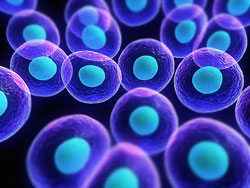
Wellcome Trust Sanger Institute scientists and their collaborators at the University of Cambridge have created a new technique that simplifies the production of human brain and muscle cells allowing millions of functional cells to be generated in just a few days. The results published in Stem Cell Reports open the door to producing a diversity of new cell types that could not be made before.
Human pluripotent stem cells offer the ability to create any tissue, including those which are typically hard to access, such as brain cells.
In a human, it takes nine to twelve months for a single brain cell to develop fully. To create human brain cells, including grey matter (neurons) and white matter (oligodendrocytes) from an induced pluripotent stem cell, it can take between three and twenty weeks using current methods. However, these methods are complex and time-consuming, often producing a mixed population of cells.
The new platform technology, OPTi-OX, optimises the way of switching on genes in human stem cells. Scientists applied OPTi-OX to the production of millions of nearly identical cells in a matter of days. In addition to the neurons, oligodendrocytes, and muscle cells the scientists created in the study, OPTi-OX holds the possibility of generating any cell type at unprecedented purities, in this short timeframe.
To produce the neurons, oligodendrocytes, and muscle cells, scientists altered the DNA in the stem cells. By switching on carefully selected genes, the team “reprogrammed” the stem cells and created a large and nearly pure population of identical cells. The ability to produce as many cells as desired combined with the speed of the development gives an advantage over other methods. The new method opens the door to drug discovery, and potentially therapeutic applications in which large amounts of cells are needed.
An author of the study, Dr Ludovic Vallier from the Wellcome Trust Sanger Institute said: “What is really exciting is we only needed to change a few ingredients — transcription factors — to produce the exact cells we wanted in less than a week. We over-expressed factors that make stem cells directly convert into the desired cells, thereby bypassing development and shortening the process to just a few days.”
OPTi-OX has applications in various projects, including the possibility to generate new cell types which may be uncovered by the Human Cell Atlas. The ability to produce human cells so quickly means the new method will facilitate more research.
Joint first author, Daniel Ortmann from the University of Cambridge, said: “When we receive a wealth of new information on the discovery of new cells from large scale projects, like the Human Cell Atlas, it means we’ll be able to apply this method to produce any cell type in the body, but in a dish.”
Mark Kotter, lead author and Clinician from the University of Cambridge, said: “Neurons produced in this study are already being used to understand brain development and function. This method opens the doors to producing all sorts of hard-to-access cells and tissues so we can better our understanding of diseases and the response of these tissues to newly developed therapeutics.”
Reference: Matthias Pawlowski, Daniel Ortmann, Alessandro Bertero, Joana M. Tavares, Roger A. Pedersen, Ludovic Vallier, Mark R.N. Kotter. Inducible and Deterministic Forward Programming of Human Pluripotent Stem Cells into Neurons, Skeletal Myocytes, and Oligodendrocytes. Stem Cell Reports, 2017; DOI: 10.1016/j.stemcr.2017.02.016





